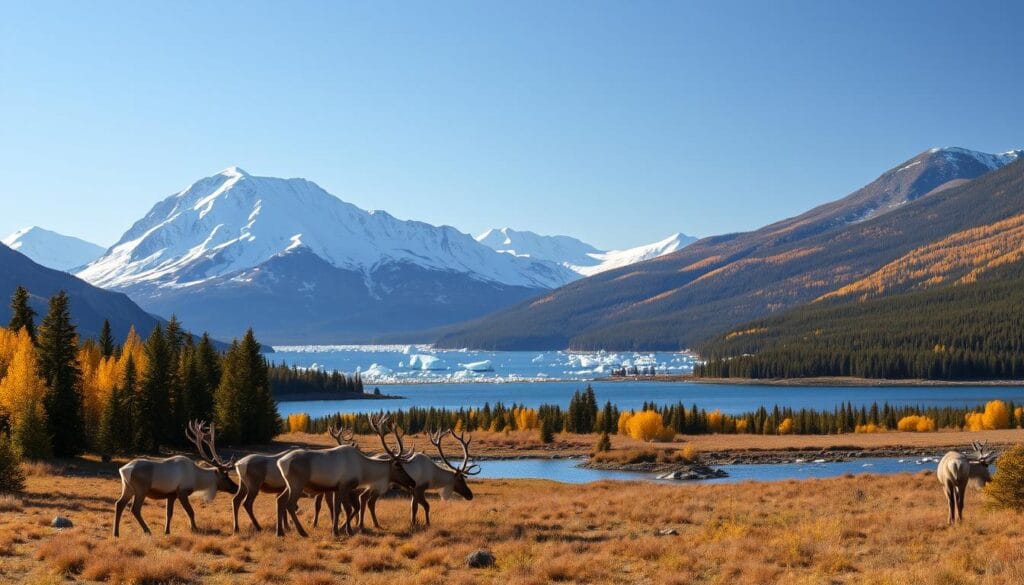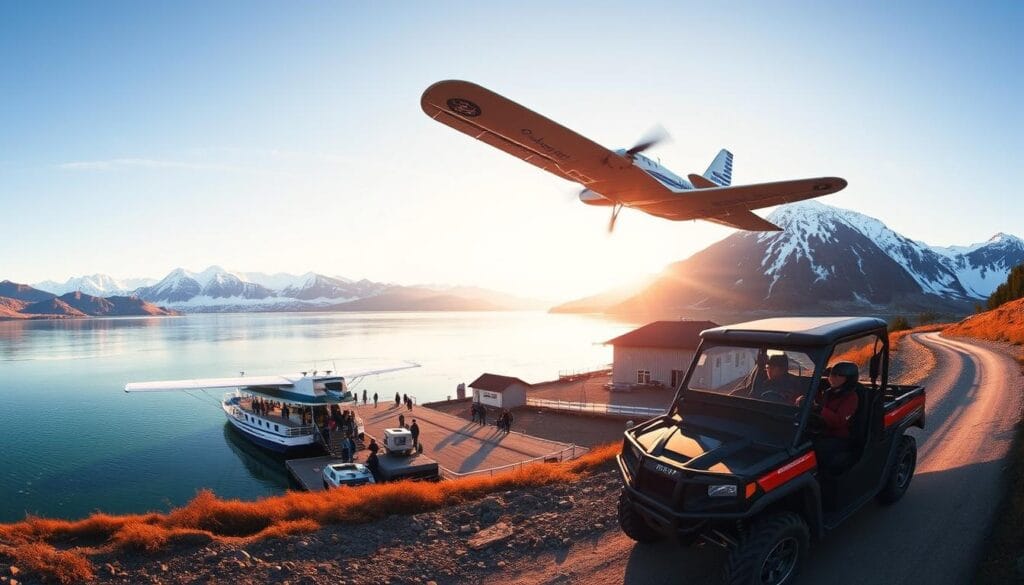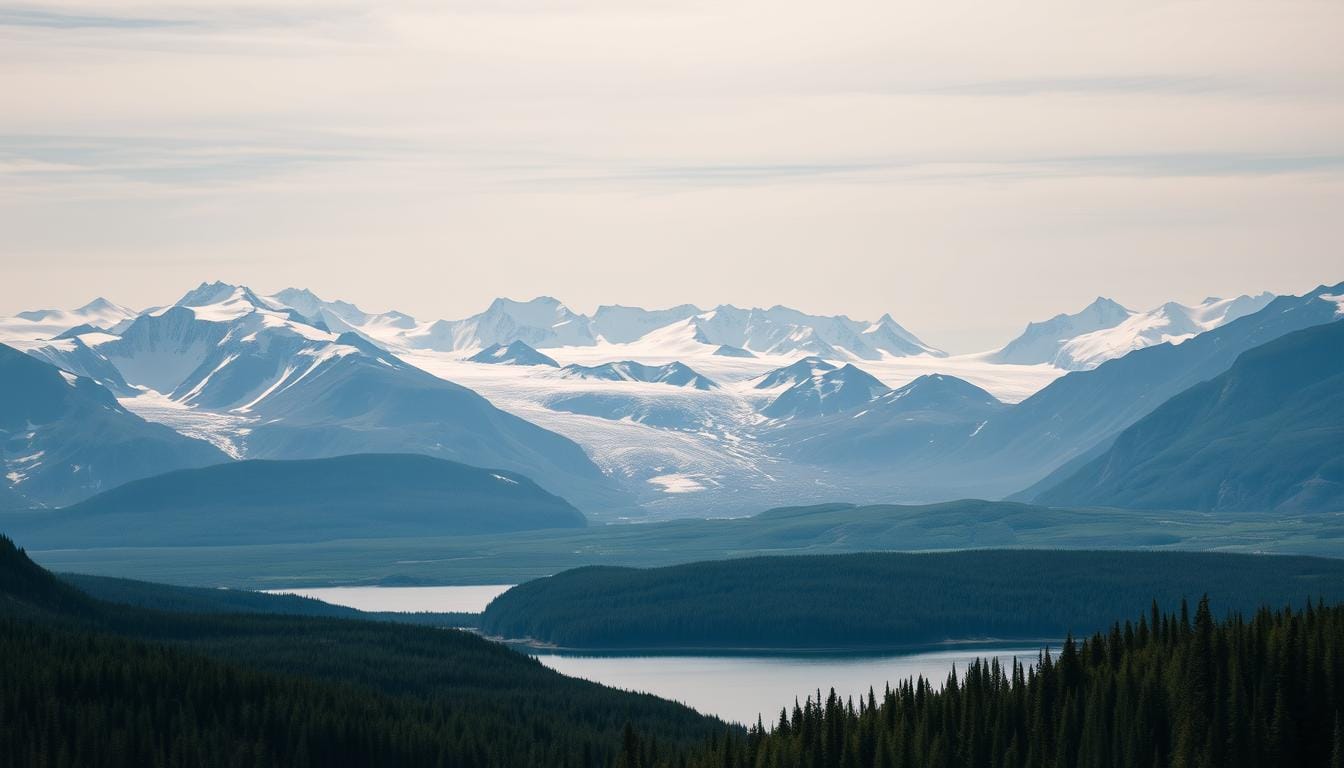Experience Alaska: Your Ultimate Guide Travel & Tips
Alaska is America’s last great wilderness. It’s a breathtaking place for travelers looking for the best Alaska experience. The state has amazing landscapes, from huge glaciers to lush rainforests.
Your Alaska travel guide starts with learning about this unique place. Most visitors come in the summer months of June through August. Planning ahead is key for a memorable trip.
Alaska offers incredible moments, from wildlife to glacier adventures. Each area has its own special experiences. You’re sure to find something amazing.
Table of Contents
Best Way to Experience Alaska: A Seasonal Guide
Alaska is a stunning place with changing landscapes and experiences. The best time to visit greatly affects your trip. So, timing is key for an amazing adventure.
Understanding Alaska’s seasons is crucial for planning your trip. You’ll see midnight sun in summer and magical northern lights in winter. Each season offers unique ways to explore.
Summer Adventures (May to September)
Summer in Alaska is magical with long days and bright landscapes. From May 10 to September 15, you’ll enjoy:
- Temperatures ranging from 60°F to low 70°F
- 16-24 hours of daylight
- Peak wildlife viewing opportunities
- Accessible hiking trails
Winter Wonders (October to April)
Winter turns Alaska into a white wonderland, ideal for northern lights fans. Winter offers:
- Aurora viewing from late August to early April
- Dog sledding adventures
- Shorter daylight hours creating magical atmospheric conditions
- Unique winter wildlife encounters
Shoulder Season Benefits
The shoulder seasons of May and September are great for saving money. You can enjoy:
- 10-25% discounts on hotels and tours
- Fewer tourist crowds
- Potential northern lights viewing
- Unique transitional landscape photography opportunities
Every season in Alaska offers a unique experience. Your trip will be unforgettable, no matter when you go.
Planning Your Perfect Alaska Itinerary
Creating the perfect Alaska adventure needs careful planning. Your trip can be as short as 4 days or as long as two weeks. Most people find 7-10 days ideal to see the state’s varied landscapes and fun activities.
- Seasonal availability of activities
- Specific regions you want to explore
- Personal interests in wildlife, scenery, and outdoor experiences
- Budget and travel time constraints
Alaska fishing trips are great for all anglers. The state has many clean rivers and coastal waters full of fish. Top fishing spots include:
- Kenai River
- Bristol Bay
- Southeast Alaska coastal regions
Booking your Alaska adventure tours needs careful timing. Pro tip: Book your trip at least six months in advance. This is especially true for the summer peak season. Alaska welcomes millions of visitors each year, so early booking is key to get the best experiences.
Alaska offers unparalleled wilderness adventures that cater to every traveler’s dream of exploration and natural beauty.
Think about making a flexible itinerary. Mix planned tours with unexpected finds. Alaska has something for everyone, from wildlife watching to fishing and scenic train rides. It promises an experience that goes beyond a typical vacation.
Must-Visit Destinations in Alaska’s Regions
Alaska is a treasure trove of landscapes and experiences. From the coast to the mountains, you’ll find breathtaking spots. Each area offers a chance to explore Alaska’s national parks and enjoy glacier cruises.
Inside Passage Highlights
The Inside Passage is a stunning coastal area for sea lovers. Ketchikan, known as the “Salmon Capital of the World”, is a must-see. It boasts amazing totem pole collections and marine wildlife.
- Explore Tongass National Forest, the largest temperate rainforest globally
- Visit Glacier Bay National Park, spanning over 3 million acres
- Experience marine wildlife viewing in pristine coastal environments
Southcentral Alaska Attractions
Southcentral Alaska has diverse landscapes and cities. Anchorage is a great place to start your journey. It’s close to many natural wonders.
| Location | Key Features |
|---|---|
| Talkeetna | Confluence of three rivers, scenic mountain views |
| Kenai Peninsula | Fjords, wildlife, spectacular national parks |
| Prince William Sound | Pristine marine ecosystems and glacier cruises |
Interior Alaska Landmarks
Interior Alaska is all about wilderness. Denali National Park is the highlight, with North America’s highest peak. It also has 91 miles of scenic road.
- Denali stands at 6,190 meters (20,310 feet)
- Fairbanks provides unique “Midnight Sun” experiences
- Alaska Highway offers stunning 1,400-mile scenic route
Southwest Alaska Experiences
Southwest Alaska is known for its wildlife and landscapes. Lake Clark National Park shows the area’s beauty. It has rainforests, volcanoes, tundra, and salmon-rich rivers.
Your trip to Alaska will be filled with unforgettable moments. Each region offers a unique view of the state’s natural wonders.
Wildlife Viewing and Natural Wonders

Alaska is a paradise for wildlife lovers. It’s home to over 50,000 black bears and 35,000 brown bears. This makes it a unique place for wildlife viewing.
There are many ways to see Alaska’s wildlife. Bear-viewing tours use planes or boats for close encounters. You might see 15 to 20 bears in their natural setting.
- Spot 40,000 bald eagles (over half of North America’s population)
- Observe hundreds of harbor seals during day cruises
- Explore Denali’s 95-mile Park Road to see Alaska’s “Big 5” wildlife
Alaska glacier cruises are another way to see the state’s beauty. Day cruises cost between $150 and $200. They offer half to full-day trips with wildlife and glacier views.
| Wildlife Location | Notable Species | Viewing Opportunities |
|---|---|---|
| Denali National Park | Wolves, Moose, Grizzly Bears | Park Road wildlife viewing |
| Seward Highway | Dall Sheep | Roadside wildlife observation |
| Lake Clark National Park | Brown Bears | Densest bear population in North America |
For a deeper experience, try specialized tours. Remember to always keep a safe distance and respect the environment during wildlife encounters.
Alaska’s Cultural Heritage and Native Traditions
Your alaska travel guide wouldn’t be complete without exploring the rich tapestry of Indigenous cultures that define Alaska’s unique identity. The state is home to an extraordinary diversity of Native peoples. Each has deep-rooted traditions that have survived for thousands of years.
Alaska boasts 229 federally recognized tribes, representing a remarkable mosaic of cultural traditions. The Native communities include:
- Iñupiat of the Arctic regions
- Yup’ik of southwestern Alaska
- Aleut from the Aleutian Islands
- Tlingit and Haida of Southeast Alaska
- Athabascan peoples of the Interior
Indigenous Peoples and Communities
Your alaska travel guide can help you understand the profound connection Native Alaskans have with their land. 15.7% of Alaska’s population identifies as American Indian or Alaska Native. This makes their cultural presence significant and vibrant.
“Our traditions are not just history—they are a living, breathing part of who we are.” – Anonymous Native Alaskan Elder
Traditional Customs and Arts
Native Alaskan arts are breathtaking expressions of cultural identity. From intricate totem poles in Southeast Alaska averaging 25-30 feet tall to traditional handicrafts, these artistic traditions tell profound stories of survival and connection.
Cultural Centers and Museums
For an immersive experience, visit these incredible cultural destinations:
- Alaska Native Heritage Center in Anchorage
- Over 1 million visitors since 1999
- Summer admission: $29 for adults
- 4.5/5 Tripadvisor rating
- Anchorage Museum
- Totem Heritage Center in Ketchikan
Your alaska travel guide recommendation: Respect local cultures, ask permission before photographing, and support Native businesses during your visit.
Transportation and Getting Around

Exploring Alaska’s vast landscape needs careful planning. The state’s unique geography offers both challenges and exciting travel opportunities. It’s perfect for the adventurous traveler.
Alaska offers various transportation options, from scenic train rides to air travel. Anchorage is the main hub, connecting travelers to many places across the state.
Transportation Modes
- Alaska Railroad: Scenic routes connecting major destinations
- Flights: Essential for reaching remote locations
- Marine Highway Ferries: Coastal travel experiences
- Road trips: Rental vehicles for flexible exploration
Transportation Cost Comparison
| Transportation Method | Average Cost | Coverage |
|---|---|---|
| Alaska Railroad | $89-$250 | Anchorage to Denali/Seward |
| Car Rental | $70-$150/day | Statewide access |
| Domestic Flights | $100-$300 | Remote destinations |
For a travel tip, start in Anchorage. It’s a great base with many transportation options. You can use public buses for $2.00 per ride or take shuttle services.
“Transportation in Alaska is an adventure itself, not just a means of getting from point A to point B.” – Alaska Travel Experts
Keep in mind that winter can affect travel. Some rental companies have rules about driving on unpaved roads. Always check your route before you go.
Outdoor Adventures and Activities
Alaska is a top spot for adventure lovers. It has untouched wilderness and stunning views. There are many tours for all skill levels and interests.
Alaska’s terrain is unlike anywhere else. It’s perfect for both seasoned adventurers and newcomers. The state’s outdoor activities are sure to leave lasting memories.
Glacier Expeditions
Glacier tours in Alaska are unmatched. The Matanuska Glacier offers an 8-hour trek. You’ll see amazing ice formations and landscapes.
- Matanuska Glacier Ice Fall Trek: Full-day exploration
- Exit Glacier Nature Hike: Family-friendly 2.5-hour experience
- Mendenhall Glacier: Accessible by land, air, and sea
Fishing Excursions
Alaska is famous for its fishing. The Copper River is known for its salmon. Guided tours help you catch salmon and trout.
| River | Notable Features | Best Fishing Season |
|---|---|---|
| Copper River | Rapid water, rich salmon population | June-August |
| Kenai River | Trophy salmon and rainbow trout | May-September |
Hiking and Backpacking
Alaska is great for hiking and dog sledding. The Perseverance Trail in Juneau is a 3-mile journey. It goes from city to wild landscapes.
- Rainforest and Waterfalls Trek: 2-4 miles through Tongass National Forest
- Magical Old-Growth Creek Trek: 3.2-mile roundtrip with small group sizes
- White Pass Mountaineering Adventure: Full-day experience for experienced hikers
Your Alaska adventure is waiting. Get ready for an unforgettable journey in the world’s most amazing wilderness.
Essential Tips for Your Alaska Journey
Planning your Alaska trip needs careful thought and insight. Your guide should focus on being flexible and adaptable. Alaska’s weather and landscapes are unpredictable, making this journey special.
Alaska’s weather calls for smart packing and awareness. Wear layered clothes, with waterproof outer layers for rain and cold. Choose moisture-wicking base layers, insulating mid-layers, and a waterproof jacket for comfort outdoors.
Packing Essentials
Pack wisely with clothes that can handle different situations. Include quick-drying pants, thermal underwear, waterproof boots, and strong rain gear. Don’t forget binoculars for wildlife watching, a favorite activity for many.
Lightweight, compact gear is best for Alaska’s remote spots.
Budget Planning
Plan your Alaska budget carefully. Book places to stay and travel earlyhttps://www.nextstopin.com/activities-and-experiences/, especially in summer. Look for group deals on cruises or tours for savings. Set aside money for surprises and unique experiences like wildlife tours and glacier trips.
Safety Considerations
Keep yourself safe by knowing Alaska’s wilderness. Carry bear spray in rural areas and keep devices charged. Always tell someone where you’re going. Be ready for rough roads and spotty signals. Respect wildlife and keep a safe distance. Your safety and preparation will make your trip unforgettable.
FAQ
When is the best time to visit Alaska?
How long should I plan for an Alaska trip?
What wildlife can I expect to see in Alaska?
What transportation options are available in Alaska?
What should I pack for an Alaska trip?
Are Alaska adventure tours suitable for all skill levels?
How can I respectfully engage with Alaska’s Native cultures?
What are the costs associated with an Alaska trip?
What safety precautions should I take in Alaska?
Can I see the Northern Lights in Alaska?
Source Links
- https://alaskatours.com/alaska-stories/plan-alaska-vacation/ – Planning a Vacation to Alaska | Alaska Travel Guide 2024 | Top 10 Tips
- https://www.alaska.org/trip-ideas – Alaska Trip Ideas | Sample Itineraries for Your Vacation
- https://www.travelalaska.com/explore-alaska – Explore Alaska – Travel Articles & Itineraries
- https://www.alaska.org/advice/best-time-to-visit-alaska – The Best Time To Visit Alaska | Plan Your Trip
- https://www.salmonberrytours.com/best-ways-to-see-alaska/ – Best Ways to See Alaska: Travel Guide & Tips | Salmon Berry Tours
- https://www.travelalaska.com/plan-your-alaska-vacation – Plan Your Alaska Vacation
- https://www.alaskacollection.com/alaska/stories/planning-a-trip-to-alaska-our-expert-advice/ – Planning a Trip to Alaska: Our Expert Advice
- https://alaskatours.com/where-travel-in-alaska/ – Alaska Travel Destinations, National Parks, Regions, Cities | Map
- https://theplanetd.com/best-places-to-visit-in-alaska/ – 25 Best Places to Visit in Alaska In 2024
- https://www.alaska.org/advice/alaska-wildlife – Best Alaska Wildlife Viewing Experiences
- https://www.nathab.com/alaska-northern-adventures/alaska-wildlife-safari/ – Alaska Wildlife Tour | Natural Habitat Adventures
- https://www.alaska.org/advice/alaska-culture – Alaska Native Culture | Alaska’s Best Cultural Tours and Experiences
- https://www.royalalaskanmovers.com/alaska-traditions-cultural-practices/ – Your Guide to Alaska Traditions & Native Cultural Practices
- https://alaskatours.com/alaska-stories/guide-to-alaska-native-heritage-center/ – Guide to Alaska Native Heritage Center | ANHC Events, Visitor Tips
- https://www.lonelyplanet.com/articles/getting-around-alaska – How to get around Alaska by ferry, train or RV
- https://www.anchorage.net/plan-your-trip/getting-to-alaska/best-way-to-visit-alaska/whats-the-best-way-to-travel-alaska/ – What’s the best way to travel Alaska?
- https://www.alaska.org/advice/alaska-adventures – Alaska’s Top Adventure Travel Trips | The Ultimate List
- https://voyij.com/blog/thrill-seekers-guide-to-alaska-exciting-outdoor-adventures-for-summer?srsltid=AfmBOookwMqM5o9c1siq5_A8tHeOj35mdcjZ7bVJz9nk_omfRqxkkueF – Thrill Seeker’s Guide to Alaska: Exciting Outdoor Adventures for Summer | Voyij.com
- https://www.traveljuneau.com/things-to-do/outdoor-activities/ – Juneau Excursions Await on Your Next Alaska Adventure
- https://adventuresmithexplorations.com/trips/alaska/6-ways-travel-alaska-right/ – What’s the Best Way to See Alaska? Try These 6 Tips
- https://www.nationalgeographic.com/travel/article/alaska-travel-guide – The essential guide to visiting Alaska

